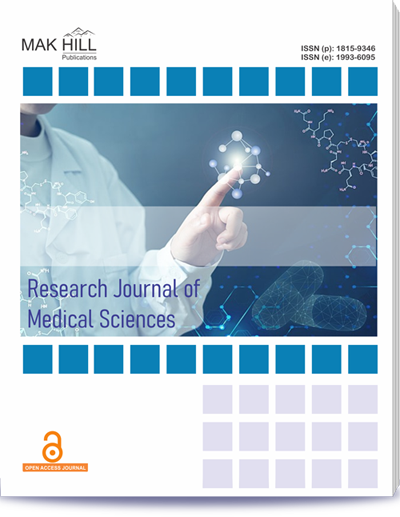
Research Journal of Medical Sciences
ISSN: Online 1993-6095ISSN: Print 1815-9346
153
Views
16
Downloads
Abstract
Worldwide, up to 10% of pregnancies are complicated by hypertensive problems during pregnancy 1. At 50,000‐60,000 fatalities annually, it is one of the main causes of maternal and neonatal mortality and morbidity. To reduce maternal and fetal morbidity and mortality due to complications of Hypertensive disorder of pregnancy. To study the effect of HDP in mother and fetus. To study the effect of early medical intervention in the form of lower threshold Anti‐hypertensive therapy in hypertensive disorders of pregnancy patients and to compare the feto‐maternal outcome of lower threshold AHT with the conventional BP level AHT at BP 150/100 mm Hg. The present study was a Prospective Comparative Observational study. This Study was conducted from February 2020 to July 2021 (18 months) at Department of Obstetrics and Gynaecology of Chittaranjan Seva Sadan College of Obstetrics, Gynaecology and Child Health, Kolkata. The two groups for starting AHT were. Study group A : 100 (with BP > = 140/90 and <150/100). Study group B : 100 (with BP> = 150/100. In our study, level of AST (40.0%) was greater in Group‐B than in Group‐A. (28.0%) but it wasnot significant (Z = 1.79, p = 0.073) and also proportion of deranged level of ALT (40.0%) was greater in Group‐B than in Group‐A (29.3%) yet, it was insignificant. (Z = 1.63, p = 0.10). Percentage of maternal outcomes that are not linked to the start of AHT at lower threshold blood pressure, such as eclampsia, disruption, HELLP syndrome and pulmonary oedema. Although Group‐B proportion of SNCU admission (18.0%) was higher than Group‐A (9.0%), the difference was not statistically significant. (Z = 1.86, p = 0.06). Proportion of APGAR score <7 (18.0%) was greater in Group‐B than in Group‐A (9.0%) yet, it was insignificant. (Z = 1.86, p = 0.06) In our study the risk of APGAR Score in 5 min being <7 in group B was 1.4 times more than group A (RR‐1.40 (1.03,1.91) p = 0.06). The mean birth weight of neonates of Group‐A was significantly higher than that of Group‐B (t198 = 2.45, p = 0.015). Proportion of LBW (42.0%) was greater in Group‐B than in Group‐A (24.0%) it is significant (Z = 2.70; p = 0.006). Proportion of IUGR (31.0%) in Group‐B was higher than that of Group‐A (18.0%) it is significant (Z = 2.13, p = 0.032). There appears to be a lower risk of abnormal LFT, a depressed APGAR score, and SNCU admission in terms of prevention of the progression of severe hypertension, development of IUGR and low birth weight babies, derangement of kidney function and thrombocytopenia. Additionally, starting anti‐hypertensive therapy at a lower threshold blood pressure is beneficial. All of these factors include tight blood pressure control in HDP.
How to cite this article:
S. Divya, Ashis Kumar Mukhopadhyay, Maya Mukhopadhyay and Arindam Halder. Anti Hypertensive Therapy in Hypertensive Disorders of Pregnancy: Lower Threshold Versus Conventional Level Therapy.
DOI: https://doi.org/10.36478/10.59218/makrjms.2024.3.134.140
URL: https://www.makhillpublications.co/view-article/1815-9346/10.59218/makrjms.2024.3.134.140